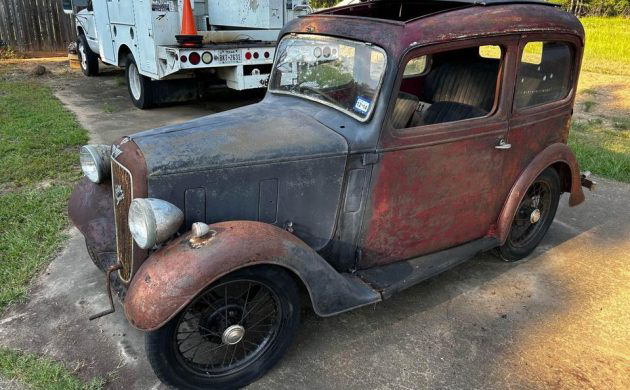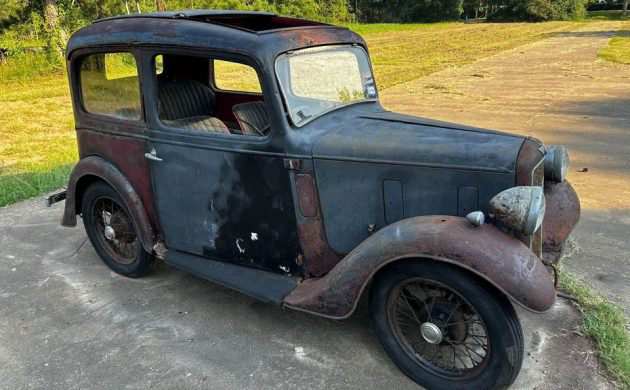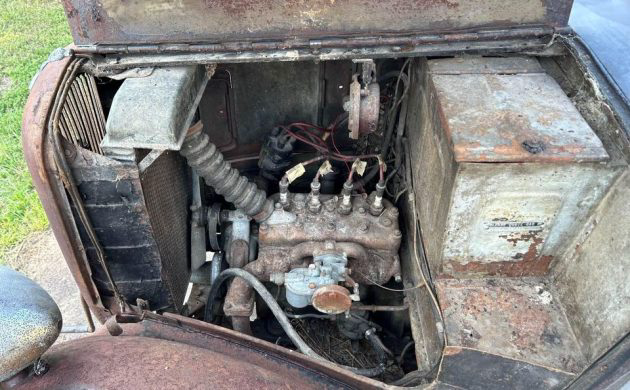Mobilizing the masses was one of the main aims of the automotive industry during the first half of the 20th Century. This approach spawned affordable vehicles like the Ford Model T, the Volkswagen Beetle, and this 1939 Austin Seven. It has spent years in dry storage, but beneath the baked paint is a classic that is surprisingly solid and complete. I must say a big thank you to Barn Finder Zappenduster for spotting a tiny car that could represent an excellent and affordable project candidate.
Austin initially resisted the temptation to produce a small car, with its larger models representing an excellent profit source. However, it soon became clear that a high-volume small car could generate similar income, so it commenced development of the car that would eventually be known as the Seven in 1920. The company unveiled its latest model in 1923, with our feature car one of the last to roll off the line in 1939. Its history is unclear, although its baked paint and lack of apparent penetrating rust suggest it may have spent much of its life in its current location. There is plenty of dry surface corrosion, but the photos suggest the new owner won’t be breaking out the grinder or welder during this build. The panels are straight, and while a total restoration will undoubtedly involve a nut-and-bolt process, the simple construction techniques employed by Austin should make that a piece of cake. Most of the key components are present, although question marks are hanging over the glass. Many bright trim items require a trip to the platers, and handing the wire wheels to a specialist for inspection to ensure they are fit for purpose would be wise.
The interior shots suggest that this Seven was a refurbishment project that stalled many years ago. It features reupholstered seats and new door trims, although the person performing the work didn’t utilize the original materials. However, there is no appreciable wear, and deep cleaning everything might produce results that make another retrim unnecessary. The Seven earned the nickname “The Baby Austin,” and with a wheelbase of just over six feet, it is easy to see why. It would be understandable to expect the car to be a two-seater, but there is room in the back seat to occupy two children. Therefore, this British classic could be ideal for an enthusiast with a young family. I have seen a Seven with four adults on board, but those who endured that experience stated that it wasn’t particularly pleasant!
The Seven’s physical dimensions weren’t its only modest figures, because the engine bay houses a 747cc flathead four. This produced 10hp at the 1923 unveiling, but ongoing development saw that figure climb to a staggering 16.5hp by the time our feature car rolled off the line. The power feeds to the rear wheels via a four-speed manual transmission, giving the Seven a potential top speed of around 50mph. However, that little four will often protest at that speed, so accepting a more modest speed would be wise. It appears the car hasn’t seen active service for years, and the engine doesn’t currently run. The seller states that it turns freely, which might allow the buyer to coax it back to life relatively easily.
Austin had a hit on its hand with the Seven, selling over 290,000 vehicles during the seventeen-year production run. The robust nature of these classics allowed them to soldier on for years with only routine maintenance, but frantic development during the 1930s meant that time caught up with the Seven by the end of the decade. Finding a good one can be challenging, but lifting this 1939 model to a high standard should be straightforward and rewarding. The seller has listed this diamond in the rough here on Facebook Marketplace in Lufkin, Texas. Their price of $7,500 makes it undeniably affordable, and if you crave a car from an era when life was more laid back, this Austin deserves a close look.







…only a couple of years ago-used to see one of these in rush hour traffic in West London driven by a lady taking her two small children to private school. It kept up well with the slow moving traffic and practical for such use. Quite a following here in the UK
In the British children’s book “Mr. Gumpy’s Motorcar” four adults in this Austin is called “a bit of squash”.
I think it would be fun to mess with and get it running and driving again but I’m not sure what to do with it after that.. Rat rod it with a Toyota v6 or just restore it
Hell yeh!
I knew the Austin 7 was licensed in the US, Australia, Germany, and Japan. But who knew the humble Austin 7 had a racing history?
https://silodrome.com/history-austin-7/
This is also a great site to read about the history of the Austin 7 right from it’s birth on Herbert Austin’s billiard table.
Now this thing is cool. I just love every angle. Especially the rear view. It’s got that “formal” look but if you stood next to it for perspective it would look like a toy.
Put a Hayabusa in it!
Nope.
Maybe if the original engine were missing, but it’s not from this example.
We live in a place that requires driving on an interstate standard highway to go anywhere. It is well patrolled, limit is 65, so traffic flows at a usual 75 or so. And there are 10 continuous miles of a 6% grade with a water tank 2/3rds of the way up for those overheating. Anything less than 60 is dangerous to the slowpoke. So this and the Hudson small 6 and any number of 30’s cars are dangerous. On the other hand, the Imperial would hold its own very nicely, as would any number of higher priced 30’s cars, especially Buicks, Caddys, and Packards with an 8 cylinder engine, V or straight. But unless retrofitted with dual braking systems, and bias-look radial tires, danger lurks there.
We are lucky here in very rural East Tennessee. There are back/farm roads to get anywhere we need to go. We share these same roads with farm equipment and horses.
rural east tenn here… :)
Priced beyond optimistic reality – $7500 should buy a good runner in England and with shipping you will still have change leftover.
geesh – ’20’s, ’30s, 40’s, 50s, 60s, well may B in the 70s the Brits finaly found fashion? Many of the cars (small % made for the wealthy) looked just like this (larger by one or two sizes, stretched a lill here… or there). Clothing? not much different. I bet they still eat the same. Ya know what? I’ll sure drink w/them (fantastic beers) but the last decade’n 1/2 usa has really got the world on many of these micro brews (check the international ratings).
I’d drive this car anywhere in my city (as after all, THAT was the application). But not more, farther, etc…
What’s great about these cars from over yonder, is the stories that come forth describing peoples lives that weren’t really much different than us Yanks, just a different mode of transportation. These cars resembled our cars of the previous era, but the proportions are all wrong. Still, folks didn’t have much choice, and this is what they drove. Obviously not for our roads with a top speed of just over 50, and 1/4 mile times unknown, stop watches only went to 15 minutes. Not the British intent. Unlike their American cousins that needed Niagara Falls down the intake, the British were a bit more civilized, and this worked for them. The 2 blade fan in Arizona won’t cut it, but again, must have worked in England. Aside from some goofy American business prop, it should go back to its homeland. How it got to Texas in the 1st place is anyone’s guess.
Friend in high school had three of these, a convertible, a coupe and a sedan like this one. The coupe needed a clutch and the engine was light enough that a couple of school kids (us) just picked it up and set it on the garage floor. The test drive proved that anyone bigger than we were were not going to fit in that car. I can’t think of an engine small enough to replace the stock units. It’s that small.
I laughed at the statement that the rear seats are suitable for only TWO children! Back in about 1943 my father had a 1938 Austin Seven Ruby, which this car is, and he decided to do a one day, 40 mile each way trip to the seafront. In that little car my Dad drove, my Mother sat in the front passenger seat with my one year old brother on her lap, my Grandfather in the back with my 8 year old brother on his lap, and me at 4 years old on my Grandmothers lap next to him! Great times!
The significance of this car putting the English in motion, it also, under licence, was built in Russia, Japan, France, Germany (the factory bought out by BMW to be their first four wheeler) and even the USA – the American Austin evolved into Bantam, the true originator of the WWII Jeep!
I grew up in a family of 6. We had a late 70’s square body regular cab chevy truck. We would all pile into the cab. Dad drove, Mom sat by the passenger door, my oldest brother held someone, mom held someone, and I always volunteered to sit next to dad, so I didn’t have to hold anyone. By the way, the truck was manual transmission so I had to stradle the floor shifter. I just remember when he would shift into reverse (I think it was reverse), I had to move my leg or I got the shifter smacked into my knee. Ahh…the good old days before seat belt laws. Back when you could ride in the bed of the truck too. Still amazes me though that we all squeezed into the cab of that truck.
Might make a fun EV if you wanna do it. With battery packs getting smaller
and more powerful than ever, you might make it work. There would indeed be a lot of things to sort out
before you even start turning wrenches. Might be better to leave this one with Edd China and let him
figure it out. Used to watch Wheeler
Dealers every Wednesday night after I
got my late MIL bedded down as she
had been diagnosed with Dementia in
2016. That show was a really great
way to best the stresses of running a
house with disabled people who often
needed help with something. Evenings were my time to de-stress
and de-compress watching those two
take a run down old car and turn it into something that you’d really want.
Also did s portrait of one of these a
few years back. Painted it dark green
with black fenders. And the more I sketched it out, the more it looked like
a ’34 Ford to me. Just might wanna
revisit this car for another portrait.